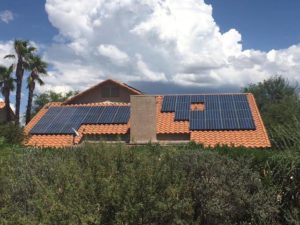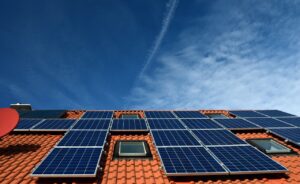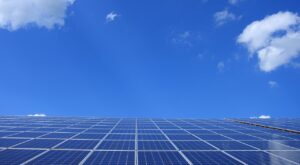Weather can have a significant impact on the efficiency of solar panels. The efficiency of solar panels is determined by their ability to convert sunlight into electricity, and various weather conditions can affect the amount of sunlight reaching the panels and their overall performance. Here's how different weather conditions can influence the efficiency of solar panels in Arizona:
Sunlight Intensity: Solar panels generate electricity based on the intensity of sunlight they receive. Cloudy or overcast days can reduce the amount of direct sunlight reaching the panels, which in turn decreases their efficiency. The more intense the sunlight, the more electricity the panels can produce.
Temperature: High temperatures can actually decrease the efficiency of solar panels. Solar panels work more efficiently at lower temperatures, so excessive heat can cause a reduction in power output. This phenomenon is known as the &"temperature coefficient." Modern solar panels are designed to mitigate this effect to some extent, but it's still a factor to consider.
Dust and Debris: Accumulation of dust, dirt, and other debris on the surface of solar panels can block sunlight and reduce their efficiency. Regular cleaning and maintenance are necessary to ensure optimal performance, especially in areas with dry and dusty climates.
Rain: Rain can help clean solar panels and temporarily increase their efficiency by removing dust and dirt. However, heavy rain or frequent rain can also obscure the sunlight and reduce efficiency, especially if the rainwater forms a film on the panel's surface.
Snow: Snow can cover solar panels and prevent sunlight from reaching the photovoltaic cells. This can drastically reduce or even stop electricity generation until the snow is cleared. In regions with heavy snowfall, solar panels are often installed at an angle to help shed snow more easily.
Shading: Shading from trees, buildings, or other obstacles can significantly impact solar panel efficiency. When a part of the panel is shaded, it can create a"hot spot" that not only reduces the overall power output but can also cause damage to the shaded cells if not properly designed.
Haze and Pollution: Airborne particles, such as smog and haze, can scatter sunlight and reduce its intensity. This can have a negative effect on solar panel efficiency, especially in areas with high levels of air pollution.
Low Light Conditions: Solar panels can still generate some power in low light conditions, such as during dawn and dusk. However, their efficiency is much lower compared to full sunlight.
Seasonal Changes: The changing seasons can also impact solar panel efficiency. In many regions, solar panels are installed at an angle to maximize their exposure to the sun's rays throughout the year. Adjusting the tilt angle with the changing seasons can help optimize energy production, especially during the winter months when the sun is lower in the sky.
Altitude and Latitude: Solar panel efficiency can also be affected by the altitude and latitude of the installation site. At higher altitudes, the air is generally clearer, which can result in higher solar panel efficiency. However, at higher latitudes, the angle of the sun changes more drastically throughout the
year, which may require more frequent adjustments to the tilt angle of the panels.
Energy Storage: In regions where weather conditions can lead to intermittent solar energy generation, having an energy storage system (like batteries) can help store excess energy generated during sunny periods for use during cloudy or nighttime conditions. This can enhance the overall efficiency of the solar energy system by ensuring a more consistent power supply.
Microclimates: Local microclimates can also play a role in solar panel efficiency. Some areas might experience more frequent cloud cover or fog due to specific geographical features. These microclimates can impact the average amount of sunlight the panels receive over time.
Weather-Resistant Design: Solar panels are designed to withstand various weather conditions, including rain, wind, and hail. Proper installation and quality components are crucial to ensure the panels remain efficient and undamaged over time.
Monitoring and Maintenance: Regular monitoring and maintenance of solar panels are essential to ensure their efficiency is maintained. Monitoring systems can help detect issues such as shading, malfunctioning panels, or a decrease in performance, allowing for timely maintenance and repairs.
Advancements in Technology: Ongoing advancements in solar panel technology aim to improve efficiency under different weather conditions. Some technologies, like bifacial solar panels that can capture sunlight from both sides, or solar panels with anti-reflective coatings, are designed to enhance energy capture and minimize the impact of weather-related factors.
Overall, while solar panels can still produce electricity under various weather conditions, their efficiency is optimized under direct sunlight and cooler temperatures. When designing a solar energy system, we consider local weather patterns in Arizona and factors that might affect panel performance to ensure you get the most out of your investment.
In conclusion, weather conditions have a multifaceted impact on the efficiency of solar panels. While certain weather conditions can reduce their efficiency temporarily, proper design, installation, and maintenance practices can mitigate these effects and ensure that solar panels continue to provide a reliable and sustainable source of clean energy. When considering the installation of solar panels, it's important to work with our experts who can assess Arizona weather patterns and tailor the system to
maximize its potential in the given our environment.

Monday - Friday 7AM to 5PM
Saturday - by appointment only
We proudly serve Green Valley, Marana, Oro Valley, Saddlebrooke, Sahuarita, Tucson, Vail, and the surrounding areas.



